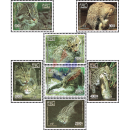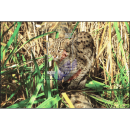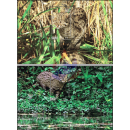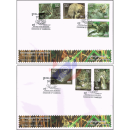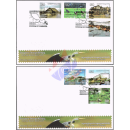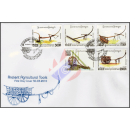Description
Opr. (5x2 with gutter); A = perf. K 13; B = imperforated
Souvenir Sheet-FDC(I), Date of issue: 22.02.2019
Picture descriptions:
dsi) Fishing Cat (Prionailurus viverrinus)
2639 B 6000 R multicolored dsi
Souvenir Sheet issue with MiNo. 2639B
Souvenir Sheet 343B (120 mm x 80 mm) dsk
Quantity FDC(I): 100 pieces
Designer: Cambodia Post
Printer: Vietnam Printing
Conservation Status:
Here as a Souevenir Sheet FDC (Version I) with imperforated Souvenir Sheet and first day special postmark
Issue Notice:
- Souvenir Sheet 343B with MiNo. 2639B was issued only as imperforated version!
- The fishing cat (Prionailurus viverrinus) is a medium-sized wild cat of South and Southeast Asia. Since 2016, it is listed as Vulnerable on the IUCN Red List. Fishing cat populations are threatened by destruction of wetlands and have declined severely over the last decade. The fishing cat lives foremost in the vicinity of wetlands, along rivers, streams, oxbow lakes, in swamps, and mangroves.
- The fishing cat is the largest of the Prionailurus cats. Its coarse fur is olive-grey to ashy-grey with darker stripes on the shoulder and roundish or oval-shaped spots on the flanks and sides. The short and rounded ears are set low on the head, and the back of the ears have a white spot. Two stripes are on the cheeks, and four stripes run from above the eyes between the ears to the shoulder. The underside is white, and around the throat are two rows of spots. The tail is short, less than half the length of head and body, spotted at the base and with a few black rings at the end. It is about twice the size of a domestic cat and stocky and muscular with medium to short legs. Its face is elongated. Its head-to-body length typically ranges from 57 to 78 cm (22 to 31 in), with a tail of 20 to 30 cm (7.9 to 11.8 in). It weighs from 5 to 16 kg (11 to 35 lb). The underside fur is longer and often overlaid with spots.
- Its paws are less completely webbed than those of the leopard cat, and the claws are incompletely sheathed so that they protrude slightly when retracted. Webbed feet have often been noted as a characteristic of the fishing cat, but the webbing beneath the toes is not much more developed than that of a bobcat.

